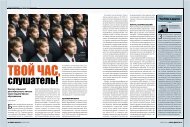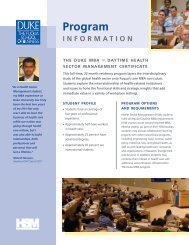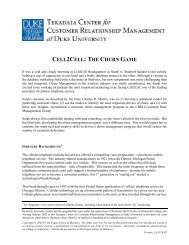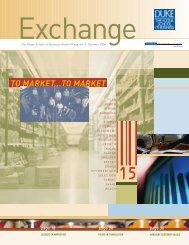Equilibrium Growth, Inflation, and Bond Yields - Duke University's ...
Equilibrium Growth, Inflation, and Bond Yields - Duke University's ...
Equilibrium Growth, Inflation, and Bond Yields - Duke University's ...
Create successful ePaper yourself
Turn your PDF publications into a flip-book with our unique Google optimized e-Paper software.
1 Introduction<br />
Explaining the nominal yield curve is a challenge for st<strong>and</strong>ard economic models. Notably, Dunn <strong>and</strong> Singleton<br />
(1986) <strong>and</strong> Backus, Gregory, <strong>and</strong> Zin (1989) highlight the difficulty of consumption-based models with<br />
st<strong>and</strong>ard preferences 1 in explaining the sign, magnitude, <strong>and</strong> volatility of the term spread. More recently,<br />
consumption-based models with richer preference specifications <strong>and</strong> model dynamics, such as Wachter (2006),<br />
Piazzesi <strong>and</strong> Schneider (2007), Gallmeyer, Hollifield, Palomino, <strong>and</strong> Zin (2007), Bansal <strong>and</strong> Shaliastovich<br />
(2010), have found success in reconciling bond prices. However, Donaldson, Johnsen, <strong>and</strong> Mehra (1990),<br />
den Haan (1995), Rudebusch <strong>and</strong> Swanson (2008, 2010), van Binsbergen, Fern<strong>and</strong>ez-Villaverde, Koijen,<br />
<strong>and</strong> Rubio-Ramirez (2010) show that extending these endowment economy models to environments with<br />
endogenous production still have difficulty in explaining the term premium jointly with key macroeconomic<br />
aggregates. This paper shows that endogenzing long-run growth prospects in a production-based model <strong>and</strong><br />
assuming agents have recursive preferences can help rationalize the slope of the yield curve jointly with a<br />
broad spectrum of macroeconomic facts.<br />
Specifically, I link nominal bond prices to firm decisions using a stochastic endogenous growth model<br />
with imperfect price adjustment. <strong>Inflation</strong> is determined by the price-setting behavior of monopolistic firms.<br />
Due to the assumption of sticky prices, in equilibrium, inflation is equal to the present discounted value of<br />
current <strong>and</strong> future marginal costs of the firm. Notably, marginal costs are negatively related to productivity,<br />
which is crucial for underst<strong>and</strong>ing the link between inflation <strong>and</strong> growth in the model. Long-run productivity<br />
growth is driven by R&D investments <strong>and</strong> leads to sustained growth. In a stochastic setting, this mechanism<br />
generates an endogenous stochastic trend <strong>and</strong> leads to substantial long-run uncertainty about future growth.<br />
This framework has two distinguishing features. First, I embed an endogenous growth model of vertical<br />
innovations 2 into a st<strong>and</strong>ard New Keynesian DSGE model, 3 which in contrast to the latter type of models,<br />
trend growth is endogenously determined by firm investments. Second, households are assumed to have<br />
recursive preferences 4 so that they are sensitive towards uncertainty about long-term growth prospects.<br />
While New Keynesian DSGE models have been successful in quantitatively explaining a wide array of<br />
empirical macroeconomic features <strong>and</strong> become the st<strong>and</strong>ard framework for modern monetary policy analysis,<br />
these models have typically found difficulty in replicating salient features in asset markets. 5 The results of<br />
this paper show that incorporating the endogenous growth margin, in conjunction with recursive preferences,<br />
1<br />
St<strong>and</strong>ard preferences in this context refers to a power utility specification.<br />
2<br />
See e.g. Grossman <strong>and</strong> Helpman (1991), Aghion <strong>and</strong> Howitt (1992), <strong>and</strong> Peretto (1999).<br />
3<br />
See Woodford (2003) <strong>and</strong> Galí (2008) for textbook treatments on this class of models.<br />
4<br />
See Epstein <strong>and</strong> Zin (1989) <strong>and</strong> Weil (1990).<br />
5<br />
See Smets <strong>and</strong> Wouters (2007) <strong>and</strong> Christiano, Eichenbaum, <strong>and</strong> Evans (2005) are examples of these models<br />
that have been able to match the impulse responses of key macroeconomic variables to nominal <strong>and</strong> real shocks.<br />
Rudebusch <strong>and</strong> Swanson (2008), Kurmann <strong>and</strong> Otrok (2011) are examples that document the failures of such models<br />
in replicating asset price facts.<br />
1
















